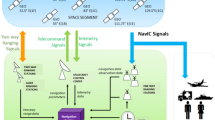Abstract
In the framework of the modernization plans of Global Navigation Satellite Systems (GNSS) a new Multiplexed Binary Offset Carrier (MBOC) modulation has been proposed as a possible Signal-In-Space (SIS) with improved performance with respect to the robustness against external sources of degradation. Discussion around such signal format are still on-going at the time of writing, anyway it is the most probable candidate signal that will be adopted by both GPS L1C and the Galileo E1 Open Service (OS) signals [(http://ec.europa.eu/dgs/energy_transport/galileo/documents/doc/2004_06_21_summit_2004_en.pdf, 2004)] as modernization of the present BOC(1,1). In the context of the integration between wireless communication and satellite navigation, one of the major problems is that usually the GNSS receiver has to work in a critical environment characterized by a heavy presence of multipath or interference sources. Some examples are urban canyons or light indoor spaces. These are also typical situations for the usage of personal communications systems. The new MBOC modulation have been studied with the specific goal to create a signal more robust with respect to multipath, bringing the high performance of Galileo in situations in which the present BOC(1,1) shows limitations. In this sense, future Location Based Services (LBS) provided on the basis of the GNSS OS will benefits from this intrinsic robustness of the signal. Throughout the paper a review of the MBOC structure will be presented, specifying that in the Galileo framework such a structure has been proposed in a version named Composite BOC (CBOC). In particular, the paper presents the simulation of the CBOC behavior in presence of multipath showing the extreme improvement with respect to other BOC solutions.
Similar content being viewed by others
References
http://ec.europa.eu/dgs/energy_transport/galileo/documents/doc/2004_06_21_summit_2004_en.pdf, 2004 Accessed Sep 2007.
Hein G.W., Rodriguez J.A., Walner S., Betz J.W., Hegarty C.J., Rushanan J., Kraay A.L., Pratt A.R., Lenahan S.Lt., Owen J., Issler J.L., Stansel T.A. (2006). The new optimized spreading modulation recommended for Galileo L1 OS and GPS L1c. Inside GNSS 1(4): 57–65
http://useu.usmission.gov/dossiers/galileo%20gps/mar2406%20joint%20statement.pdf.
http://gps.losangeles.af.mil/engineering/icwg/Docs/EC%20and%20US%20Joint%20Statement%20on%20GALILEO%20and%20GPS%20Signal%20Optimization%20-%20%2024%20Mar%2006.pdf, 2006. Acessed Sep 2007.
Kaplan, E. D., & Hegarty, C. (2006). Understanding GPS: Principles and applications. Artech House Mobile Communications Series.
Misra, P., & Enge, P. (2001). Global positioning system—signals, measurements and performance. Ganga-Jamuna Press.
Betz, J. W. (1999). The offset carrier modulation for gps modernization. ION National Technical Meeting (pp. 639–648) January 1999.
Navstar global positioning system joint program office http://www.losangles.at.mil/shared/media/document/afd-070803-064.pdf.
Betz, J. W. (2000). Design and performance of code tracking for the gps m code signal. ION National Technical Meeting, Salt Lake city, UT, September 2000.
Oppenheim, A. V., & Schafer, R. W. (1975). Digital signal processing In N. Englewood Cliffs (Ed.), Prentice-Hall.
Lindsey W.C., Chie C.M. (1981). A survey of digital phase-locked loops. Proceedings of IEEE 69(4): 410–431
Parkinson, B. W., & Spilker, J. J. (1996). In Global positioning system: Theory and applications. In P. Zarchan (Ed.), American Institute of Aeronautics (Vol. 1).
Irsigler, M., Rodriguez, J. A., & Hein, G. W. (2005). Criteria for gnss multipath performance asssessment. Proceedings of the International Technical Meeting of the Institute of Navigation, ION-GNSS (pp. 13–16). Long Beach, California.
Garin, L., Diggelen, F. V., & Rousseau, J. (1996). Strobe & edge correlator multipath mitigation for code. ION National Technical Meeting, September 1996.
Pany, T., Irsigler, M., & Eissfeller, B. (2005). Optimum coherent discriminator based code multipath mitigation by s-curve shaping for boc(n,n) and bpsk signals. Proceedings of the International Technical Meeting of the Institute of Navigation, ION-GNSS (pp. 13–16), Long Beach, California, September 2005.
Fenton, P. C., & Jones, J. (2000). The theory and performance of novatel inc.’s vision correlator. Proceedings of the International Technical Meeting of the Institute of Navigation, ION-GNSS. (pp. 13–16). Long Beach, California, September 2005.
Dovis, F., Pini, M., & Mulassano, P. (2004). Turbo dll: An innovative architecture for multipath mitigation in gnss receivers. ION National Technical Meeting of the Institute of Navigation, ION-GNSS, September 2004.
Author information
Authors and Affiliations
Corresponding author
Rights and permissions
About this article
Cite this article
Fantino, M., Mulassano, P., Dovis, F. et al. Performance of the Proposed Galileo CBOC Modulation in Heavy Multipath Environment. Wireless Pers Commun 44, 323–339 (2008). https://doi.org/10.1007/s11277-007-9372-2
Published:
Issue Date:
DOI: https://doi.org/10.1007/s11277-007-9372-2




